
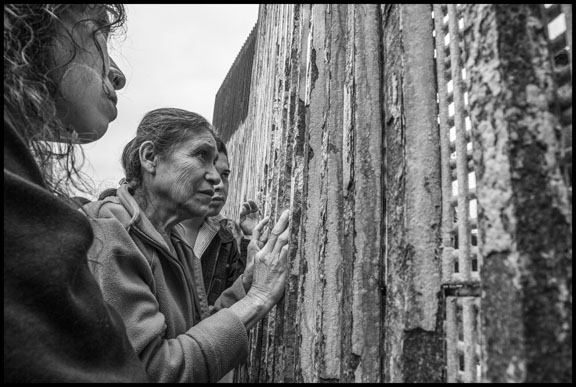 In Playas de Tijuana, on the Mexican side of the border wall between Mexico and the US, Catelina Cespedes and Carlos Alcaide greet Florita Galvez, who is on the US side. The family came from Santa Monica Cohetzala in Puebla to meet at the wall. (Photo: David Bacon)
In Playas de Tijuana, on the Mexican side of the border wall between Mexico and the US, Catelina Cespedes and Carlos Alcaide greet Florita Galvez, who is on the US side. The family came from Santa Monica Cohetzala in Puebla to meet at the wall. (Photo: David Bacon)
It took two days on the bus for Catalina Cespedes and her husband Teodolo Torres to get from their hometown in Puebla — Santa Monica Cohetzala — to Tijuana. On a bright Sunday in May they went to the beach at Playas de Tijuana. There the wall separating Mexico from the United States plunges down a steep hillside and levels off at the Parque de Amistad, or Friendship Park, before crossing the sand and heading out into the Pacific surf.
Sunday is the day for families to meet through the border wall. The couple had come to see their daughter, Florita Galvez.
Florita had arrived that day in San Ysidro, the border town a half-hour south of San Diego. Then she went out to the Border Field State Park, by the ocean, two miles west of town. From the parking lot at the park entrance it was a 20-minute walk down a dirt road to the section of the wall next to the Parque de Amistad.
At 11 that morning, Catalina and Florita finally met, separated by the metal border. They looked at each other through the metal screen that covers the wall’s bars, in the small area where people on the US side can actually get next to it. And they touched. Catalina pushed a finger through one of the screen’s half-inch square holes. On the other side, Florita touched it with her own finger.
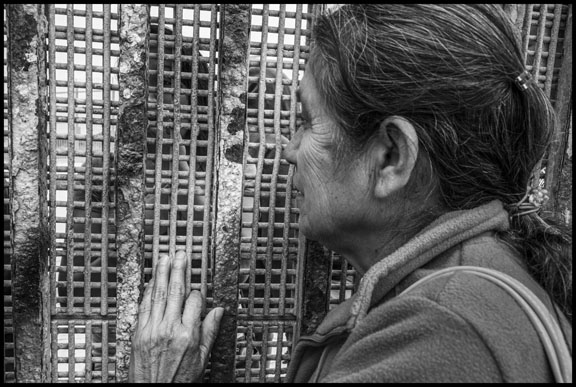 On the Mexican side of the border wall Catelina Cespedes sticks her finger through a hole in the mesh so that she can touch the finger of her daughter, Florita Galvez, on the other side. (Photo: David Bacon)
On the Mexican side of the border wall Catelina Cespedes sticks her finger through a hole in the mesh so that she can touch the finger of her daughter, Florita Galvez, on the other side. (Photo: David Bacon)
Another family shared the space with Catalina and Teodolo. Adriana Arzola had brought her baby Nazeli Santana, now several months old, to meet her family living on the US side for the first time. Adriana had family with her also — her grandmother and grandfather, two older children, and a brother and sister.
The rules imposed by the Border Patrol say that where there’s no screen, the family members on that side have to stay back several feet.
It was very frustrating, though, to try to see people on the other side through the half-inch holes. So they moved along the wall to a place where the screen ended. There the vertical 18-foot iron bars of the wall — what the wall is made of in most places — are separated by spaces about four-inches wide. Family members in the US could see the baby as Adriana held her up.
But only from a distance. The rules imposed by the US Border Patrol in Border Field State Park say that where there’s no screen, the family members on that side have to stay back several feet from the wall. So — no touching.
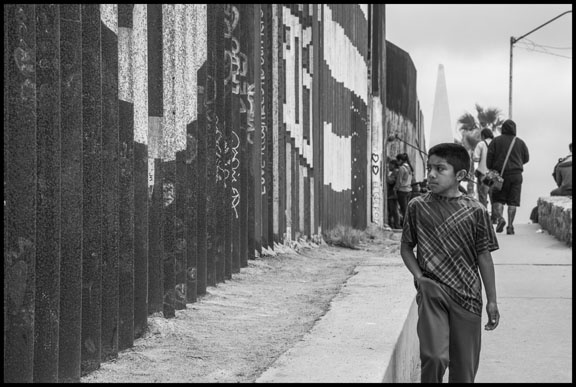 A boy walks past the Mexican side of the border wall between Mexico and the US. (Photo: David Bacon)
A boy walks past the Mexican side of the border wall between Mexico and the US. (Photo: David Bacon)
I could see the sweep of emotions playing across everyone’s faces and in their body language. One minute the grandmother was laughing, and the next there were tears in her eyes. The grandfather just smiled and smiled. Adriana talked to her relatives, and tried to wake the baby up. Her brother leaned on the bars with his arms folded against his eyes, and her sister turned away, overcome by sadness. On the US side, a man in a wheelchair and two women with him looked happy just to have a chance to see their family again.
Some volunteers, most from the US side, called “Friends of Friendship Park,” have tried to make the Mexican side more pleasant and accommodating for families. The older children with Adriana sat at concrete picnic tables. While family members talked through the wall, they used colored markers, provided by the Friends, to make faces and write messages on smooth rocks. Around them were the beginnings of a vegetable garden. Later in the afternoon one of the volunteers harvested some greens for a salad.
Such carefully controlled and brief encounters are the ultimate conclusion of a process that, at its beginning, had no controls at all. Before 1848 there was no border.
Members of the Friends group include Pedro Rios from the US/Mexico Border Program of the American Friends Service Committee, and Jill Holslin, a photographer and border activist. On the US side, another of the participating groups — Angeles de la Frontera, or Border Angels, helped the families that came to the park. “We’re here seven or eight times a month,” said Enrique Morones, the group’s director. “People get in touch with us because we’re visible, or they know someone else we helped before.” Border Angels helps set up the logistics so that families can arrive on both sides at the same time, often coming from far away.
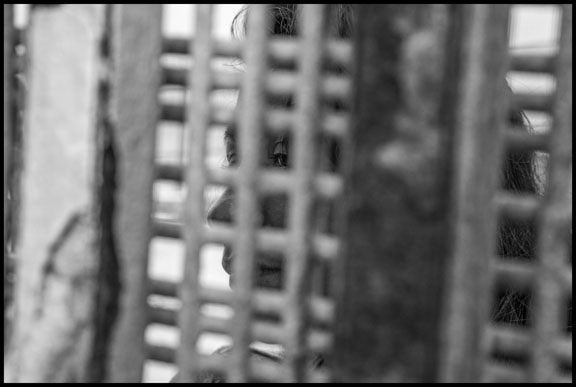 Florita Galvez is on the US side of the border wall between Mexico and the US, and her family on the Mexican side can only see her through holes in the metal mesh. (Photo: David Bacon)
Florita Galvez is on the US side of the border wall between Mexico and the US, and her family on the Mexican side can only see her through holes in the metal mesh. (Photo: David Bacon)
Weekend visiting hours, from 10 am to 2 pm, are the only time the Border Patrol allows families to get close to the wall for the reunions. Once a year they open a doorway in the wall. Watched closely by Border Patrol agents, family members are allowed to approach the open door one by one, and then to hug a mother or father, a son or daughter or another family member from the other side. To do that, people have to fill in a form and show the agents they have legal status in the US. During the rest of the year, the Border Patrol doesn’t ask about legal status, although they could at any moment. For that reason, Border Angels tells families not to go on their own.
Such carefully controlled and brief encounters are the ultimate conclusion of a process that, at its beginning, had no controls at all. Before 1848 there was no border here whatsoever. That year, at the conclusion of what the US calls “the Mexican War,” the two countries signed the Treaty of Guadalupe Hidalgo. Mexico was forced to give up 529,000 square-miles of its territory. The US paid, in theory, $15,000,000 for the land, but then simply deducted it from the debt it claimed Mexico owed it. US troops occupied Mexico City to force the government there to sign the treaty.
The so-called “Mexican Cession” accounts for 14.9 percent of the total land area of the United States, including the entire states of California, Nevada and Utah, almost all of Arizona, half of New Mexico, a quarter of Colorado and a piece of Wyoming. Some Congress members even called for annexing all of Mexico.
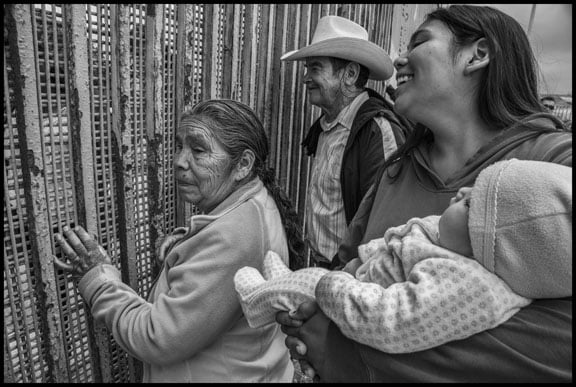 On the Mexican side of the border wall, Adriana Arzola brings her new baby, Nayeli Santana, to meet her family living in the US for the first time. Meeting families through the wall takes place every Sunday at the Parque de Amistad, or “Friendship Park,” in Playas de Tijuana, the neighborhood of Tijuana where the wall runs into the Pacific Ocean. (Photo: David Bacon)
On the Mexican side of the border wall, Adriana Arzola brings her new baby, Nayeli Santana, to meet her family living in the US for the first time. Meeting families through the wall takes place every Sunday at the Parque de Amistad, or “Friendship Park,” in Playas de Tijuana, the neighborhood of Tijuana where the wall runs into the Pacific Ocean. (Photo: David Bacon)
The Border Patrol was organized in 1924. Before that, there was no conception that passage back-and-forth between Mexico and the US on Monument Mesa had to be restricted.
At the time, the city of San Diego was a tiny unincorporated settlement of a few hundred people. It was considered a suburb of Los Angeles, then still a small town. San Ysidro didn’t exist, nor did Tijuana. To mark the new border, in 1849 a US/Mexico boundary commission put a marble monument in the shape of a skinny pyramid where they thought the line should go. A replica of that original pyramid today sits next to the wall in the Parque de Amistad. On the US side, the road leading from San Ysidro to Boundary Field State Park is named Monument Road, and the area is called Monument Mesa.
Early tourists chipped so many pieces from the marble pyramid that it had to be replaced in 1894. The first fence was erected, not along the borderline, but around the new monument to keep people from defacing it. The line itself was still unmarked, 50 years after it had been created.
The Border Patrol was organized in 1924. Before that, there was no conception that passage back-and-forth between Mexico and the US on Monument Mesa had to be restricted. The federal government only assumed control over immigration in 1890, when construction began on the first immigration station at Ellis Island in New York harbor. Racial exclusions existed in US law from the late 1800s, but the requirement that people have a visa to cross the border was only established by the Immigration Act of 1924. The law also established a racist national quota system for handing visas out.
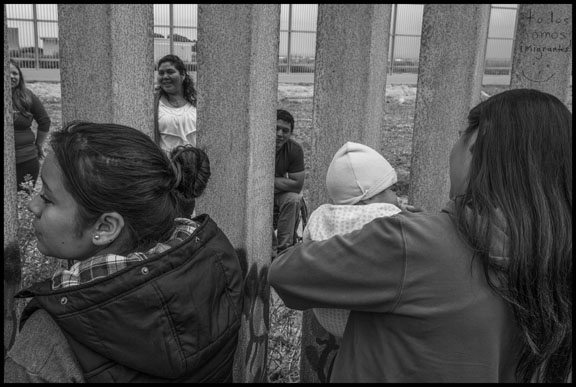 Adriana Arzola, her sister and her baby, Nayeli Santana, talk with her family living in the US through the bars of the wall. On the US side, her family has to stay several feet away from the wall, so they can’t touch each other through the bars. (Photo: David Bacon)
Adriana Arzola, her sister and her baby, Nayeli Santana, talk with her family living in the US through the bars of the wall. On the US side, her family has to stay several feet away from the wall, so they can’t touch each other through the bars. (Photo: David Bacon)
In the 1930s, the Border Patrol terrorized barrios across the US, putting thousands of Mexicans into railroad cars and dumping them across the border. Even US citizens of Mexican descent, or people who just looked Mexican, were swept up and deported. Trains carried deportees to the border stations in San Ysidro and Calexico, but on Monument Mesa there was still no formal line to keep people from returning.
That changed for the first time after World War II, when barbed wire was stretched from San Ysidro to the ocean. Mexicans called it the “alambre,” or “the wire.” Those who crossed it became “alambristas.” Yet enforcement was still not very strict. During the 1950s and early 1960s, thousands of Mexican workers were imported to the US as braceros, while many migrants also came without papers. In the Imperial Valley, on weekends during the harvest, those workers would walk into Mexicali, on the Mexican side, to hear a hot band or go dancing and then hitch a ride back to sleep in their labor camps in Brawley or Holtville.
In 1971, Pat Nixon, wife of Republican President Richard Nixon, inaugurated Border Field State Park. The day she visited, she asked the Border Patrol to cut the barbed wire so she could greet the Mexicans who’d come to see her. She told them, “I hope there won’t be a fence here too much longer.”
 At the Parque de Amistad, or “Friendship Park,” in Playas de Tijuana, children and families write on stones the names of other family members they’re separated from because of the border. (Photo: David Bacon)
At the Parque de Amistad, or “Friendship Park,” in Playas de Tijuana, children and families write on stones the names of other family members they’re separated from because of the border. (Photo: David Bacon)
The wall itself at the Parque de Amistad has become a changing artwork. As the bars rust, they’ve been painted with graffiti that protests the brutal division.
Instead, Congress passed the Immigration Reform and Control Act (IRCA) in 1986. Although many people remember the law for its amnesty for undocumented immigrants, IRCA also began the process of dumping huge resources into border enforcement. A real fence was built in the early 1990s, made of metal sheets taken from decommissioned aircraft carrier landing platforms. The sheets had holes, so someone could peek through. But for the first time, people coming from each side could no longer physically mix together or hug each other.
That old wall still exists on the Mexican side in Tijuana and elsewhere on the border. But Operation Gatekeeper, the Clinton administration border enforcement program, sought to push border crossers out of urban areas like San Ysidro, into remote desert regions where crossing was much more difficult and dangerous. To do that, the government had contractors build a series of walls that were harder to cross.
On Monument Mesa, the aircraft landing strips were replaced in 2007 by the 18-foot wall of vertical metal columns. Two years later, a second wall was built on the US side behind the first. The area between them became a security zone where the Border Patrol restricts access to the wall itself to just four hours on Saturday and Sunday. The metal columns were extended into the Pacific surf.
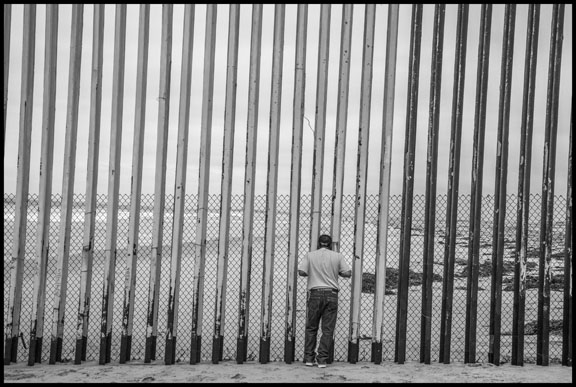 A man looks through the bars of the border wall into the US. (Photo: David Bacon)
A man looks through the bars of the border wall into the US. (Photo: David Bacon)
In Playas, though, the wall is just a sight to see for the hundreds of people who come out to the beach on the weekend. The seafood restaurants are jammed, and sunbathers set up their umbrellas on the sand. Occasionally, a curious visitor will walk up and look through the bars into the US, or have a boyfriend or girlfriend take a picture next to the wall, uploading it to Facebook or Instagram for their friends.
The wall itself at the Parque de Amistad has become a changing artwork. As the bars rust, they’ve been painted with graffiti that protests the brutal division.
One section has the names of US military veterans who’ve been deported to Mexico, with the dates of their service and death. A deported veterans group comes down on occasional Sundays, with some in uniform. In angry voices, they ask why fighting the US’ wars didn’t keep them from being pushed onto the Mexican side of the wall.
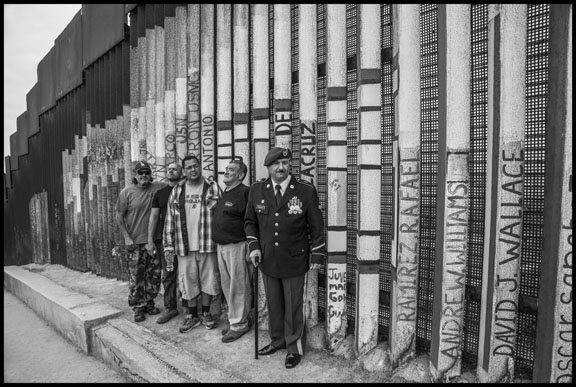 On the Mexican side of the border wall, veterans of US military service who have been deported gather to protest and to remember those who died. Their names are written on the bars. (Photo: David Bacon)
On the Mexican side of the border wall, veterans of US military service who have been deported gather to protest and to remember those who died. Their names are written on the bars. (Photo: David Bacon)
© Copyright David Bacon
5 Days Left: All gifts to Truthout now matched!
From now until the end of the year, all donations to Truthout will be matched dollar for dollar up to $50,000! Thanks to a generous supporter, your one-time gift today will be matched immediately. As well, your monthly donation will be matched for the whole first year, doubling your impact.
We have just 5 days left to raise $50,000 and receive the full match.
This matching gift comes at a critical time. As Trump attempts to silence dissenting voices and oppositional nonprofits, reader support is our best defense against the right-wing agenda.
Help Truthout confront Trump’s fascism in 2026, and have your donation matched now!